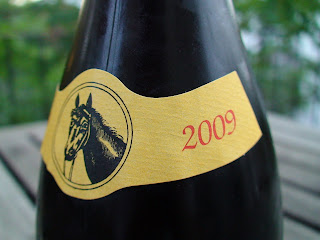Eating and Drinking Briefly in New Orleans.
I was in New Orleans recently and I had the opportunity to try out some of your recommendations from a while back. Very impressive in general, the eating and drinking in the Crescent City, but you already know that. Just a couple of things to share, almost all of them great:
Breakfast at Coulis - there is no website, but here is a quick article about the place. Finer than a diner but totally casual, this is a great place to eat breakfast. Cream cheese stuffed French toast with pralines and biscuits and sausage gravy for those of us who care not about calories, and there's yogurt and granola for the rest of you. The coffee is good, the room is sunny and cheerful, and everyone is very friendly.
Dinner at The Delachaise - This place is a bar, but it is a comfortable and mature enough place to have dinner. There are at least 30 wines by the glass and some of them are very good wines. I drank 2009 Ameztoi Txakolina by the glass, which at $7 by the glass, I felt great about. So great that although I wasn't planning on it, I ordered dinner, a green salad and a grass-fed strip steak from a farm not too far away (Arkansas, I think). High quality and delicious all around, although the 2007 Trenel Fleurie I drank with the steak was not very interesting or snappy. This is a great casual spot for a a glass or two and dinner, and I would unhesitatingly go back.
Cork and Bottle Wines/Clever Wine Bar - The retail store seemed good enough. But the thing that got me about this place is the fact that I could buy a bottle of NV Diebolt-Vallois Blanc de Blancs off the shelf ($46), and walk through an archway to the aptly named Clever Wine Bar, and drink that very wine at no extra charge. No, I am not kidding. I did this at 5:30 pm on a Wednesday, and had I done it later in the evening, there would have been a corkage fee. But even if that fee was $10 or $15, that's still a pretty cheap way to enjoy Champagne of that caliber at a wine bar.
 Dinner at Pascale's Manale - the woman behind the register at Coulis recommended this place to me when I asked where I should go for dinner to eat something special from New Orleans. "BBQ shrimp at Pascale's," she said. The walk was lovely, the restaurant was absolutely old school and would have been at home in New Haven or Arthur Avenue in the Bronx. But I thought that the food and drink was a bit simple, as if they decided that it is better to offend no one than to thrill anyone. My seafood gumbo was fine, but not really seasoned in any way. And those BBQ shrimp - they certainly were fresh and high quality shrimp. But they sat in a shockingly deep pool of butter. Butter, a bit of pepper and Tabasco, that's it. This is well executed food, but unimaginative and under seasoned. It made me think of someplace that my grandparents and their friends in Florida would flock to at around 4:45 each evening, if I had grandparents in Florida. Even my Sazerac cocktail was too syrupy and sweet.
Dinner at Pascale's Manale - the woman behind the register at Coulis recommended this place to me when I asked where I should go for dinner to eat something special from New Orleans. "BBQ shrimp at Pascale's," she said. The walk was lovely, the restaurant was absolutely old school and would have been at home in New Haven or Arthur Avenue in the Bronx. But I thought that the food and drink was a bit simple, as if they decided that it is better to offend no one than to thrill anyone. My seafood gumbo was fine, but not really seasoned in any way. And those BBQ shrimp - they certainly were fresh and high quality shrimp. But they sat in a shockingly deep pool of butter. Butter, a bit of pepper and Tabasco, that's it. This is well executed food, but unimaginative and under seasoned. It made me think of someplace that my grandparents and their friends in Florida would flock to at around 4:45 each evening, if I had grandparents in Florida. Even my Sazerac cocktail was too syrupy and sweet.Dinner at Cochon - The culinary highlight of the trip. This restaurant is as good as everyone said it would be - it exceeded all of my expectations. The space is warm and inviting. Cocktails were excellent. We ate a lot, and honestly everything was delicious. Well, I didn't love the fried Boudin, but that's it, everything else was excellent. Fried alligator with Tabasco aioli was great (and I believe one should never pass up the opportunity to eat an animal that if given the chance, would happily eat you).
 Smokey pork ribs with pickled watermelon, cornmeal dusted ham hock with black eyed peas and limas, cochon (like pulled pork) with cracklins, rabbit with greens and cornmeal dumplings, sides of smothered lima beans and okra...all of these things really delivered. Thankfully I went with people so I could sample all of these different things.
Smokey pork ribs with pickled watermelon, cornmeal dusted ham hock with black eyed peas and limas, cochon (like pulled pork) with cracklins, rabbit with greens and cornmeal dumplings, sides of smothered lima beans and okra...all of these things really delivered. Thankfully I went with people so I could sample all of these different things.I'm going back in a few weeks and my goal is to make friends with the po' boy. Perhaps even the Muffalleta.




























